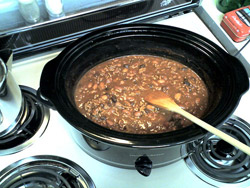 LEAVE IT ALONE:
LEAVE IT ALONE: The main advantage of slow cooking is to set and forget it. You do not need to tend the pot. By all means do not hesitate to leave your home while your crockpot is on. DO make sure it is not touching the walls or other appliances.
STIRRING:
Stirring is not required for the great majority of crock- pot recipes. Occasionally I encounter one that requires basting, but that is most infrequently.
KEEP IT COVERED LEAVE THE LID ON:
I cannot stress this point enough. Every time the crockpot is uncovered, 1/2 cooking time is lost.
NEVER remove the lid during the first two hours when baking breads or cakes. Most pots have a
glass lid, so you can see pretty much what is going on inside. If for some reason you must open the
pot, make sure you do all your additions then to minimize overall heat loss.
COOKING TIMES:
It is best to follow the recipe's instructions, but a general rule of thumb is ONE HOUR ON HIGH
EQUALS TWO HOURS ON LOW. If for some reason you cannot be there at exactly the time specified to
turn it off, don't worry. Because of the low cooking temperatures your food will not burn.
HIGH ALTITUDE COOKING:
Allow more time than given in the recipe at altitudes over 4000 feet. TEMPERATURES There are
generally two temperature settings, low and high. Low is 200 degrees and high is 300 degrees.
FROZEN FOODS:
When using frozen foods in a recipe, thawing prior to adding them to the pot is essential, actually more because you risk damage to a ceramic pot liner more than anything. If you have a metal crockpot you may add frozen items but several extra hours of cooking time must be added as well. (JO's note) (I have cooked frozen food successfully)
SPICES:
Because so little evaporation takes place when cooking with this method, spices tend to be
intensified. I am careful not to over-season and just before serving make my corrections.
FOIL SPEEDS COOKING:
To save time, aluminum foil may be placed under the crock pot lid. The foil reflects the heat back onto the food and I feel keeps the heat in the pot a little more efficiently.
VEGETABLES:
Vegetables intended for the crockpot should be cut into bite-size pieces not only for convenience in eating, but for better cooking, too. Surprisingly, vegetables can take longer to cook than meat in Crockpots. The vegetables will be more tender if you cut the veggies into pieces around 1/2 inch.
USING THE CROCKPOT AS AN OVEN:
When the oven is full and all burners on the range are in use, (as in cooking a holiday dinner), pull out your crockpot. You can cook such things as bread, puddings, baked beans and custard in the crockpot.
USING THE CROCKPOT AS A STEAMER:
You can prepare steamed bread or pudding in a shaped molds or jars in the crockpot, too. Do NOT
use shortening cans, coffee cans or vegetable cans for cooking the crockpot. Most cans contain lead
and are painted with or sealed with materials that give off toxic gases when heated.
CANNING:
If you use jars, use only Canning jars. They are tempered and will withstand the heat. Choose straight-sided canning jars with WIDE mouths because otherwise it's more difficult to get the food
out of the jars. To assure that the bake cake or bread will slip out easily, grease the inside of the jar and lie the bottom of the jar with waxed paper. Cover each jar with a piece of foil greased on one side. Place the greased side DOWN and press the foil around the edges of the jar to seal tightly.
BEVERAGES:
When it's cold and damp outside, you can simmer hot beverages which will stay at perfect sipping
temp. And the aroma of spiced tea or punch will appeal to your family and/or guests. They can serve themselves from the crockpot.
PARTY TIME:
Dips and other appetizers such as meatballs will stay at the right temp. and consistency for
several hours in the crockpot. You can buy crockpots up to a 6-quart size which are ideal for most recipes.
